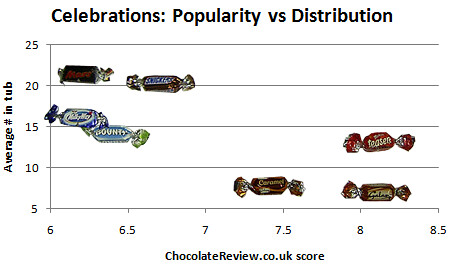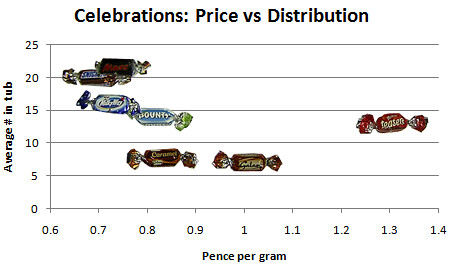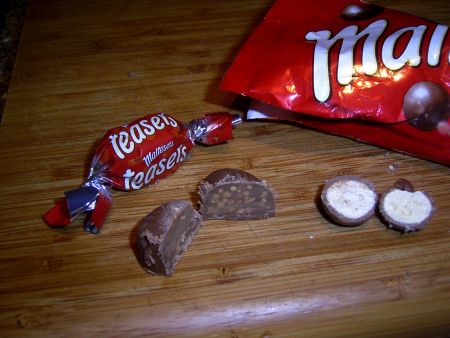In the previous post I described my experiment regarding the distribution and popularity of the different chocolates found within a Celebrations tub. After several months of rumination, cogitation, and procrastination, I am ready to publish my findings.
(Incidentally, this is fully the intended publishing style for this blog – posts appearing infrequently, but with a fair amount of thought and effort behind them, which is the style I prefer to find myself when browsing through the RSS feeds I subscribe to).
I should note that I have since discovered some prior work in the field: popular newspaper The Sun reported on the unfair distribution of Celebrations chocolates way back in 2006, although their methods were not so rigorous. In response to claims of ‘scrooge tactics’, Masterfoods responded “The mix is made up of different quantities of various brands. Research shows that’s what people prefer.” We shall see how that statement holds up against a more scientific examination of the facts.
The results of the auctions were, sadly, inconclusive. Only three of the tubs sold (the Mars, Maltesers ‘teasers’, and Galaxy tubs), all for the starting bid. I had thought I could at least use the number of views of each auction as a simple proxy for popularity, but on closer examination this seemed to have been biased by the order in which the listings appeared, with the first and last listed gaining a disproportionate number of views.
(I am currently auctioning off the remaining tubs, still well within their use-by date, in time for Easter and with free postage. The auctions end April 5th 2009 and can be found here.)
Fortunately I discovered an alternative measure of chocolate popularity: The Chocolate Review, where different chocolates are scored out of 10, with most chocolates receiving over 50 votes. With this information in hand, I was able to plot out the relationship between the average number found in a tub and the popularity of a given chocolate.

First conclusion: the more delicious a chocolate is, the rarer it tends to be.
The correlation is clear but not perfect, and it should also be noted that the scores are for the full-size purchase versions of these chocolates, which differ somewhat from the Celebrations size – particularly the Maltesers ‘teasers’. Also note that the Galaxy Truffle is not scored on the Chocolate Review, although I strongly suspect that this would follow the correlation.
One natural explanation for this apparent injustice would be that more delicious chocolates cost more to make per gram, and as such the cost of a Celebrations tub is kept down by skewing the distribution towards cheaper varieties. Checking the details of the chocolates in their standard form on Tesco’s site, I was able to estimate the cost-per-gram of each type, with the following result:

(I have added the pricing and popularity data to the original results Google docs spreadsheet).
Second conclusion: more delicious chocolates are more expensive, pretty much. Such is life.
This brings us to the final and crucial question: is the distribution of Celebrations chocolates in a tub mercilessly determined by the average cost per gram alone?

The Maltesers ‘teasers’ location is clearly an outlier. This is almost certainly due to the fact that these ‘teasers’ are significantly different to regular Maltesers, so the cost-per-gram used here is incorrect. Checking with two local shops I found the cost-per-gram of Maltesers to be the same, so the Tesco pricing was not an anomaly. Disregarding this datapoint, we can be fairly certain of the final and most damning deduction, which stands in marked contrast to Masterfoods’ disingenuous statement.
Third conclusion: chocolate distribution is determined by price, not deliciousness.
There is one beacon of hope visible from these apparently bleak results. Anecdotally (read: in my opinion), and as suggested by the successful sale of such a tub, Maltesers ‘teasers’ are in fact quite notably delicious, arguably more so than regular Maltesers – yet the results strongly suggest that they are far cheaper to produce. If we examine a cross-section of the two types, the differences become clear:

So we reach our final and most optimistic conclusion:
Fourth conclusion: Maltesers ‘teasers’ may well be more delicious than their cost would suggest, and could potentially be developed into their own independent product line.
Further research is needed in this area, but I think for now I shall move on to other areas of research.
-metatim
Edit (07/04/2009): On the bottom of the tub, the ‘teasers’ have the following description: “Everybody’s favourite, grab ’em before they’re all gone!”. It seems Mars (formerly Masterfoods) have indeed done some research, and it endorses my final conclusion.
Second Edit (14/04/2009): A figure that was conspicuously absent from this analysis: given the standard distributions and cost-per-gram of each chocolate, a natural question to ask is: what is value of the standard tub contents? Assuming truffles cost the same as galaxies and that teasers actually do fit the distribution/cost trend, my estimate is £7.69. Since the standard price of a tub seems to be about £5, this means that these tubs are actually a very efficient way to buy chocolate. This data has been added to the Google Docs spreadsheet.
Third Edit (17/07/2013): Much has changed in the ~4.5 years since this research was originally conducted. For one thing, the amount of chocolate in the tubs was reduced. Mini Twixes have now been added to the mix, (based on a couple of tubs, these appear to have largely substituted Mars/Snickers, so evening the distribution a little). Finally and most importantly, Mars did indeed launch a stand-alone ‘Teasers’ offering. Hooray!
Fourth Edit (11/09/2015): These days there are only 750g of Celebrations in a tub, the truffles are out, Twixes are in. You can find out what the distribution looks like over on Mental Floss.
11 replies on “The Celebrations Experiment: The Results”
Aha! I have an explaantion for why people think the rare ones are delicious!
It’s because they’re rare that they’re more desirable, and thus percieved as more delicious. People would probably rate Oysters as more desirable than pizza, but thats only because they associate oysters with a rare and gourmet treat, and pizzas with run-of-the-mill. If pizza was really rare and oysters common I contend the deliciousness scale would be different!
So I believe that if milky way and mars were less numerous in the tin they would be more desirable!
That might have been true if my measure of popularity had come from the eBay results, but since they instead come from the ratings on ChocolateReview.co.uk of the widely-available high-street versions of these chocolates, I don’t think it is the case!
That said, there could well be such an effect for the Galaxy Truffle and the Malteasers ‘teasers’, since they don’t seem to be available in any other form. But I think the results for the other chocolates are fairly clear.
Masterfoods say “The mix is made up of different quantities of various brands. Research shows that’s what people prefer.” You could read that simply as meaning that people prefer different quantities of different brands. Which they plainly do, as some are perceived as more delicious than others. Masterfoods are saying that they deliver different quantities of different brands. They’re not necessarily saying that their distribution correlates to the customers’ preferred distribution!
I agree with the Teasers analysis. They are different, and I prefer the Teasers variety to the Maltesers variety. I wonder if the spherical nature is the key to the expense? Teasers can easily be made with a conventional mould. I’m not sure how you’d make a Malteser shape easily in a manufacturing process. Wikipedia states “The exact manufacturing process is a trade secret.”
Absolutely, that’s exactly how you could read it, but in the context it’s such a non-sequitur that it is very likely to be misread, which is why I describe it as disingenuous.
Good point about the manufacturing difficulty of Maltesers (which I only now realise I have been misspelling all this time, I shall make corrections) – that seems very likely to be the reason for their relatively high cost-per-gram, and is a fascinating puzzle in its own right.
Maltesers have been available since 1936, and in my mind at least have been largely identical throughout the time I’ve been aware of them (which is at least 30 years.) I would suggest that if it were any great manufacturing challenge to make spherical Maltesers rather than ovoid ones, then a) it would not have been practical to do so with 1936 technology and b) would have been the target of a revised design years ago.
I would think that the ‘Teaser is so designed so that it fit within the Celebrations selection, in terms of size and density, rather than there being any kind of shortcut involved in its manufacturing.
Apparently we’ve all been guilty of not reading the cited links on Wikipedia – there are a lot of fascinating suggestions about the manufacturing process here:
http://www.guardian.co.uk/notesandqueries/query/0,,-6315,00.html
I agree the ‘Teasers’ are designed to fit with the selection, but I think the interesting part is that it seems in so doing they have stumbled upon a potentially profitable new chocolate to sell independently, since the cost-per-gram would appear to be less than the inferred deliciousness.
[…] of the Octopus tagline pending « First! The Celebrations Experiment: The Results […]
[…] is just a quick update on my previous posts about the distribution of chocolates in tubs of […]
[…] [Read the full results at this post's new location, Tower of the Octopus] […]
[…] Blog A rare event — I updated my blog, with the results from my Celebrations experiment. […]
[…] Tower of the Octopus The Octopus Fruitbat games blog Skip to content HomeAbout ← First! The Celebrations Experiment: The Results → […]